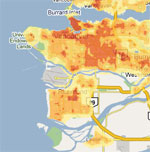A new report by Sightline Institute finds that Greater Vancouver, BC’s overall smart-growth record slipped in recent years, despite impressive growth in pedestrian-friendly neighbourhoods in some parts of the region. From 2001 through 2006, the share of new urban and suburban growth that went into compact, walkable communities declined and the amount of land developed to accommodate new residents increased, compared with the 1990s.
Slowing Down: Greater Vancouver’s smart-growth leadership slipsAlso see:
- Press release: Greater Vancouver’s Leadership in Smart Growth Slips
- Sprawl and Smart Growth in Selected Northwest Cities
British Columbia’s government has set ambitious goals for reducing climate-warming emissions in the province. Because the transportation sector is British Columbia’s largest single source of emissions, channeling new growth into compact, walkable communities that allow residents to drive less is critical for meeting the province’s emissions goals.
Somewhat surprisingly, Greater Vancouver’s leadership in compact growth slipped during the last census period, compared with the previous decade, according to Sightline’s report. From 2001 through 2006, the share of new urban and suburban growth that went into compact communities declined, and the amount of land developed to accommodate new residents increased, compared with the two previous census periods.
However, the cities of Vancouver and North Vancouver have seen notable success in fostering walkable, pedestrian-friendly neighbourhoods. Between 2001 and 2006, for example, Vancouver’s pedestrian-oriented neighbourhoods flourished, with net growth of more than 27,000 residents–which is about four-fifths of the net population growth that occurred within city limits.
If current trends continue—and particularly if Greater Vancouver’s smart-growth record continues to slip—the region will face greater challenges in curbing climate-warming emissions in the coming decades. However, if BC’s municipalities follow the lead of Greater Vancouver’s most successful smart-growth neighbourhoods, they could set the province on course for substantial long-term emissions reductions from the transportation sector.
See also:







